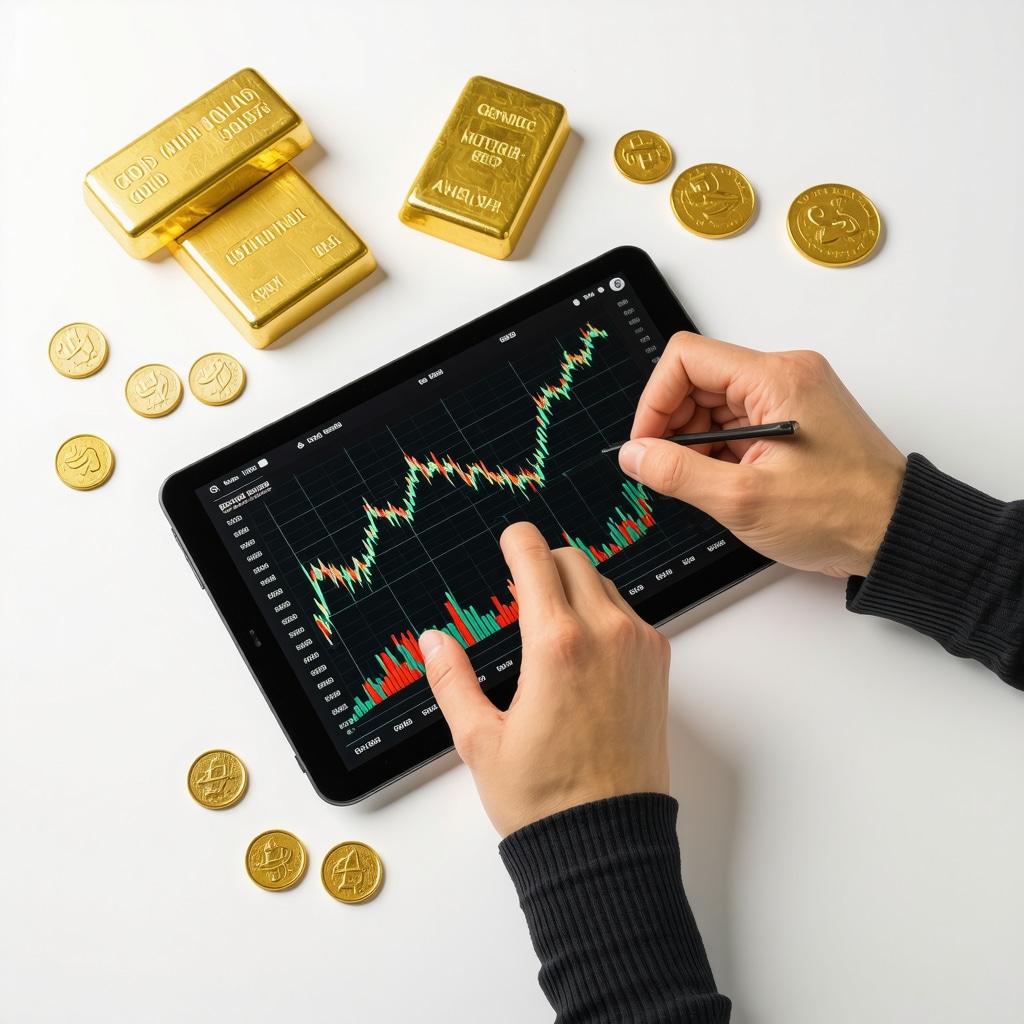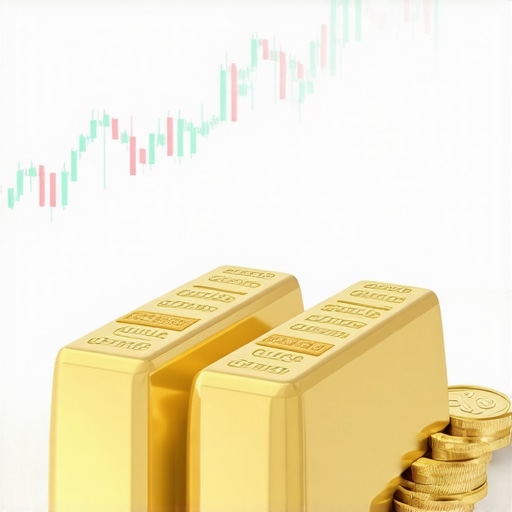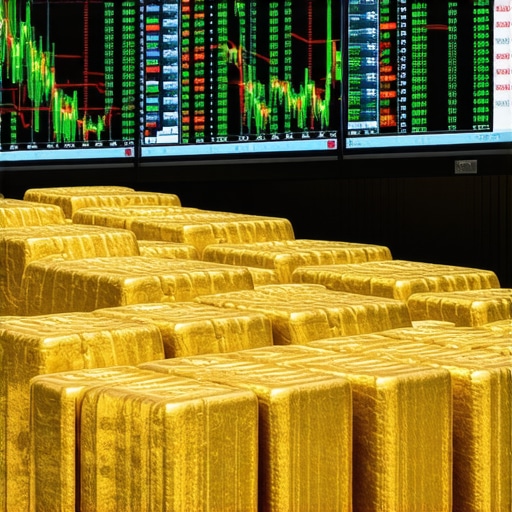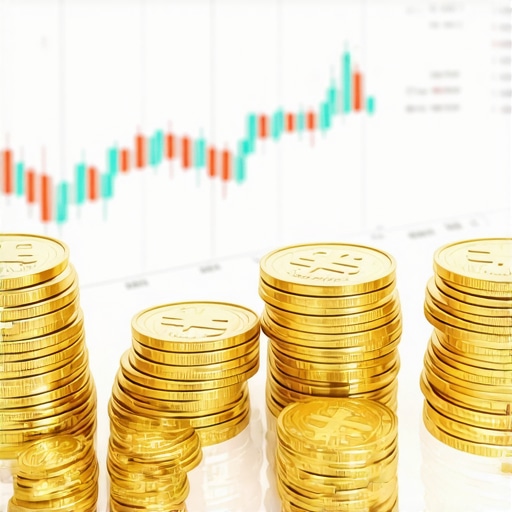Unlocking the Golden Puzzle: Why Supply and Demand Shape Gold Prices
Gold has long fascinated investors and economists alike, not just for its intrinsic beauty but for its complex market dynamics. At the heart of gold price fluctuations lies the fundamental interplay between supply and demand—a dance influenced by geopolitical tensions, central bank policies, and shifts in consumer behavior. Understanding these forces is crucial for anyone seeking to predict gold price movements with sophistication beyond mere speculation.
Unearthing Supply Factors: From Mining Output to Central Bank Reserves
The global gold supply is primarily driven by mining production, recycling, and central bank activities. Mining output, while relatively stable, can be disrupted by geopolitical unrest, labor strikes, or environmental regulations which tighten the flow of newly mined gold. Central banks, particularly in emerging economies, strategically buy or sell gold to manage reserves, with their decisions often signaling broader economic confidence or caution. For instance, recent increased purchases by central banks in Asia have contributed to tightening supply, nudging prices upward.
How Does Demand from Different Sectors Influence Gold Prices?
Gold demand is multifaceted, spanning jewelry, technology, investment, and central bank reserves. Jewelry demand, especially in markets like India and China, fluctuates with cultural events and economic prosperity, directly impacting price trends. Meanwhile, the rise of gold-backed ETFs has introduced a new dimension of investment demand, often reacting swiftly to global uncertainty. Technological uses, although a smaller percentage, remain consistent, particularly in electronics and medical devices.
Decoding Market Signals: The Role of Investor Sentiment and Macroeconomic Indicators
Investor behavior—driven by inflation expectations, currency strength, and geopolitical risks—often anticipates shifts in gold demand. For example, during periods of high inflation or currency devaluation, gold is perceived as a safe haven, increasing demand and pushing prices higher. Conversely, rising interest rates can diminish gold’s appeal by increasing opportunity costs, leading to price dips. Monitoring these macroeconomic indicators alongside supply constraints offers a nuanced framework for anticipating price movements.
Real-World Scenario: How Supply-Demand Imbalances Triggered a Price Surge in 2020
In early 2020, the COVID-19 pandemic disrupted mining operations and heightened investor anxiety simultaneously. This convergence led to a unique supply-demand imbalance: reduced supply due to lockdowns and soaring demand from investors seeking refuge in gold. The result was a historic spike in gold prices, underscoring how intertwined these factors are when forecasting market behavior.
Harnessing Data and Forecasting Tools for Smarter Gold Investment
Advanced analytics, including machine learning models and real-time market data, now empower investors to dissect supply-demand dynamics with unprecedented precision. By integrating production reports, central bank disclosures, and consumer demand trends, these tools help predict potential price fluctuations more reliably. For those keen on refining their market strategies, exploring how to analyze gold price forecasts offers practical insights into leveraging these methodologies effectively.
For authoritative insights on the global gold supply’s influence on prices, the World Gold Council provides comprehensive reports that are invaluable resources for serious investors (World Gold Council – Gold Demand Trends).
Curious about how current demand trends might reshape your investment approach? Share your thoughts or questions below, and join the conversation on mastering gold market dynamics.
Personal Reflections on the Shifting Tides of Gold Demand
Over the years, I’ve observed firsthand how demand trends in gold can pivot swiftly, reshaping investment landscapes almost overnight. For example, the surge in popularity of gold ETFs transformed what was once a market dominated by physical bullion buyers into a more dynamic environment where digital assets influenced price movements significantly. This shift taught me the importance of staying adaptable and informed, especially as new financial instruments emerge.
When I first started investing, I primarily focused on physical gold. However, witnessing how investment demand can spike during times of uncertainty made me diversify a bit. Understanding that jewelry demand in countries like India and China often follows cultural festivities helped me anticipate seasonal price fluctuations better, making my timing more strategic.
The Intricacies of Supply Constraints and How They Affect Prices
Mining disruptions, whether due to environmental regulations or labor issues, have a ripple effect that I learned to watch closely. One notable instance was when strikes in major mining regions led to supply shortages, causing unexpected price hikes. It reminded me that gold supply isn’t just about the total ounces mined annually but also about timing and accessibility, which can tighten markets suddenly.
How Can We Anticipate Gold Price Movements Amid These Complex Factors?
This question has become central to my investment approach. I find that combining real-time market data with macroeconomic indicators offers the clearest picture. For instance, monitoring inflation rates alongside central bank gold purchases can reveal when gold is poised to gain momentum. Reliable resources like the World Gold Council provide invaluable data that I’ve incorporated into my regular market reviews.
Additionally, exploring comprehensive guides such as effective gold investment strategies has helped me fine-tune my tactics, especially during volatile market periods. The key is to balance patience with informed agility, ensuring that decisions align with both long-term goals and current market realities.
Inviting You to Share Your Gold Investment Journey
Gold’s allure is undeniable, but navigating its market requires more than just luck; it demands knowledge and reflection. I’m curious—how have supply and demand trends influenced your approach to gold investing? Have you experienced moments where market shifts caught you by surprise, or have you found strategies that helped you stay ahead?
Feel free to share your experiences or questions in the comments below. Let’s learn together and build a community of informed gold investors. If you’re looking to deepen your understanding, check out key tips for beginners to start smarter and more confident on your gold journey.
Strategic Forecasting: Leveraging Macro and Microeconomic Indicators to Decode Gold Price Volatility
Predicting gold price movements requires a sophisticated synthesis of various macroeconomic signals and micro-level market data. Investors must monitor inflation rates, real interest rates, currency fluctuations, and geopolitical developments simultaneously. For example, an unexpected rise in U.S. Treasury yields can increase the opportunity cost of holding non-yielding assets like gold, often triggering price corrections. Conversely, a surge in geopolitical tensions or a weakening dollar typically signals a bullish environment for gold. Integrating these indicators with supply data—such as mining output disruptions or central bank reserve changes—can reveal nuanced price trajectories that simplistic models might miss.
How Do Central Bank Policies Specifically Influence Gold Prices Beyond Reserve Management?
Central banks influence gold prices not merely through reserve accumulation or liquidation but also via monetary policy signaling. When central banks pursue quantitative easing or signal prolonged low interest rates, investors anticipate inflationary pressures, increasing gold’s appeal as an inflation hedge. Moreover, central banks’ open market operations can indirectly affect gold by impacting currency values and liquidity conditions. For instance, the People’s Bank of China’s recent strategic gold purchases reflect both reserve diversification and geopolitical hedging, subtly shifting global market sentiment and tightening supply.
Research by the International Monetary Fund (IMF) highlights how central bank gold buying patterns correlate strongly with macroeconomic uncertainty and monetary policy adjustments, underscoring the multifaceted role of these institutions in gold price dynamics.
Technological Innovations and Their Emerging Impact on Gold Demand: Beyond Traditional Sectors
While jewelry and investment demand dominate gold consumption, emerging technologies are carving out new demand niches. Innovations in nanotechnology and biomedicine increasingly utilize gold nanoparticles for targeted drug delivery and diagnostic imaging, creating a burgeoning demand sector that is less price-sensitive but steadily growing. Additionally, the expansion of green technologies such as electric vehicles and renewable energy systems incorporates gold in connectors and sensors due to its superior conductivity and corrosion resistance.
These technological trends introduce a layer of demand stability that can partially offset volatility from investment-driven market swings. Keeping abreast of these industrial shifts provides investors an edge in anticipating long-term gold demand trajectories.
Applying Machine Learning for Enhanced Gold Price Forecasting: Opportunities and Challenges
Machine learning models have revolutionized commodity price forecasting by processing complex, high-dimensional data sets including supply disruptions, macroeconomic indicators, and investor sentiment extracted from social media analytics. Algorithms such as Long Short-Term Memory (LSTM) networks can capture temporal dependencies and nonlinear interactions in gold market data, providing more accurate short- and medium-term price predictions.
However, challenges remain in model interpretability and the incorporation of exogenous shocks like geopolitical crises. Therefore, blending machine learning outputs with expert domain knowledge remains the best practice for actionable insights.
What Are the Best Practices for Integrating Machine Learning Models with Traditional Gold Market Analysis?
Expert consensus recommends a hybrid approach: use machine learning to identify patterns and anomalies in real-time data while relying on fundamental analysis for context and validation. This dual strategy mitigates overfitting risks and ensures forecasts remain grounded in economic realities.
If you’re eager to elevate your gold investment strategy using cutting-edge analytics, explore our detailed guide on machine learning applications in gold market forecasting for actionable techniques and case studies.
Engage with Us: Share Your Insights and Questions on Gold Market Complexities
The gold market’s intricacy offers endless opportunities for learning and refinement. How have you incorporated macroeconomic indicators or emerging technologies into your gold investment decisions? Have you experimented with machine learning or other advanced tools? We invite you to share your experiences and questions below to foster a vibrant expert community dedicated to mastering gold market dynamics.
Deciphering Central Bank Influence: Beyond Traditional Reserve Strategies
Central banks wield multifaceted influence over gold prices that transcends mere reserve accumulation or liquidation. Their monetary policy signaling—through instruments like quantitative easing and forward guidance on interest rates—shapes investor inflation expectations, thereby modulating gold’s attractiveness as an inflation hedge. Additionally, central bank operations impact currency liquidity and valuation, indirectly steering gold demand. For example, the People’s Bank of China’s targeted gold acquisitions serve not only reserve diversification but also strategic geopolitical hedging, subtly constricting global supply and swaying market sentiment.
Notably, the International Monetary Fund (IMF) research elucidates a robust correlation between central bank gold buying patterns and macroeconomic uncertainty, underscoring their pivotal role in gold price dynamics.
Technological Frontiers: Emerging Industrial Demand Reshaping Gold’s Market Profile
Beyond traditional sectors, gold’s unique physicochemical properties are fueling demand in cutting-edge technologies. The utilization of gold nanoparticles in nanomedicine for precise drug delivery and diagnostic imaging exemplifies a rapidly growing, price-inelastic demand segment. Concurrently, green technologies, including electric vehicles and renewable energy systems, increasingly embed gold in critical connectors and sensors due to its superior conductivity and corrosion resistance. These applications inject a stabilizing force into gold demand, offsetting volatility from speculative investment flows and underpinning long-term price resilience.
Marrying Machine Learning with Fundamental Analysis: Elevating Gold Price Forecasting
The advent of sophisticated machine learning (ML) methodologies has revolutionized commodity price prediction. Models like Long Short-Term Memory (LSTM) networks adeptly capture nonlinear temporal dependencies within multifaceted datasets encompassing supply disruptions, macroeconomic indicators, and investor sentiment gleaned from social media analytics. Yet, challenges persist, particularly in model interpretability and accommodating unforeseen geopolitical shocks. Hence, a hybrid analytical framework combining ML-driven pattern recognition with rigorous fundamental analysis remains paramount for robust, actionable forecasting.
What Are the Best Practices for Integrating Machine Learning Models with Traditional Gold Market Analysis?
Industry experts advocate a dual-pronged strategy: deploy machine learning algorithms to detect nuanced patterns and anomalies in real-time data streams while leveraging fundamental economic analysis to contextualize and validate these insights. This synergy mitigates risks such as overfitting and ensures forecasts adhere to underlying market realities, enhancing predictive reliability.
For practitioners aspiring to harness these advanced techniques, our comprehensive guide on machine learning applications in gold market forecasting offers detailed methodologies and illustrative case studies.
Interactive Engagement: Share Your Expertise on Navigating Gold’s Complex Ecosystem
The intricate interplay of macroeconomic forces, technological innovations, and analytical advancements presents vast opportunities for refined investment strategies. Have you integrated macro indicators or emerging tech demand trends into your gold portfolio decisions? What successes or challenges have you encountered leveraging machine learning tools? We invite you to contribute your perspectives and queries below to cultivate a vibrant, expert community committed to mastering gold market complexities.
Frequently Asked Questions (FAQ)
What are the primary factors that cause gold prices to fluctuate?
Gold prices fluctuate mainly due to the dynamic balance between supply and demand. Supply-side factors include mining production levels, recycling rates, and central bank activities. Demand stems from jewelry, investment vehicles like ETFs, technology applications, and central bank reserve management. Additionally, macroeconomic indicators such as inflation, interest rates, and geopolitical risks strongly influence investor sentiment, further affecting prices.
How do central bank policies impact gold prices beyond just buying and selling reserves?
Central banks influence gold prices not only through reserve accumulation or liquidation but also through monetary policy signaling. Quantitative easing, forward guidance on interest rates, and open market operations affect inflation expectations and currency valuations, which in turn modulate gold’s appeal as a safe haven. For example, central banks’ strategic gold purchases can tighten supply and send strong market signals about economic confidence or caution.
Why is gold considered a safe haven during economic uncertainty?
Gold is perceived as a safe haven because it retains intrinsic value and is not directly tied to any one currency or economy. During periods of inflation, currency devaluation, or geopolitical turmoil, investors flock to gold to preserve wealth, driving demand and increasing prices. Its historical stability and limited supply amplify this effect.
Can emerging technologies significantly affect gold demand?
Yes, emerging technologies are gradually reshaping gold demand. Applications in nanomedicine, such as targeted drug delivery and diagnostic imaging, alongside green technology uses in electric vehicles and renewable energy systems, require gold for its unique conductivity and corrosion resistance. Although these sectors currently represent a smaller portion of demand, their growth introduces a stabilizing factor in gold consumption patterns.
How reliable are machine learning models in predicting gold price movements?
Machine learning models can enhance gold price forecasting by analyzing complex, multidimensional data including supply disruptions, macroeconomic indicators, and investor sentiment. Models like LSTM networks capture nonlinear temporal patterns effectively. However, they face challenges with interpretability and sudden exogenous shocks. Combining machine learning with fundamental economic analysis offers the most reliable forecasting approach.
What role does investor sentiment play in the gold market?
Investor sentiment, shaped by inflation expectations, currency strength, geopolitical events, and market volatility, drives demand fluctuations. Positive sentiment towards gold as a safe haven during uncertain times leads to increased buying pressure, while confidence in risk assets or rising interest rates may reduce gold’s attractiveness.
How do supply disruptions in mining affect gold prices?
Mining supply disruptions caused by labor strikes, environmental regulations, or geopolitical instability can create sudden shortages in newly mined gold. Since mining output is relatively inelastic in the short term, these disruptions tighten supply and often trigger price spikes as markets react to limited availability.
What strategies can investors use to anticipate gold price trends?
Investors should monitor a combination of real-time market data, macroeconomic indicators (like inflation and interest rates), central bank gold activities, and geopolitical developments. Integrating these with advanced analytics and machine learning forecasts, while maintaining a strong foundation in fundamental analysis, helps anticipate price movements more accurately.
How does jewelry demand influence gold prices seasonally?
Jewelry demand, particularly in cultural hubs like India and China, is highly seasonal and correlates with festivals, weddings, and economic prosperity. These predictable demand surges can cause seasonal price fluctuations, which savvy investors factor into their timing strategies.
What is the significance of gold-backed ETFs in the market?
Gold-backed ETFs have democratized investment demand, allowing broader participation through easily accessible financial products. They respond swiftly to market sentiment, amplifying investment-driven demand swings and adding liquidity and volatility to gold price movements.
Trusted External Sources
- World Gold Council (WGC): The WGC offers comprehensive and up-to-date research on global gold demand trends, supply statistics, and market analysis, serving as a foundational resource for understanding gold market dynamics.
- International Monetary Fund (IMF): The IMF provides authoritative studies on the relationship between gold prices and monetary policies, including central bank behaviors and macroeconomic impacts, essential for grasping gold’s role in global finance.
- London Bullion Market Association (LBMA): LBMA is a key industry body that tracks global gold trading standards, market data, and supply chain integrity, offering practical insights into market liquidity and pricing mechanisms.
- U.S. Geological Survey (USGS): The USGS publishes detailed reports on mining production, reserves, and supply chain disruptions, critical for understanding the supply side of gold pricing.
- Academic Journals on Commodity Markets and Machine Learning Applications: Peer-reviewed research papers provide in-depth analyses of advanced forecasting models and emerging technological influences on gold demand, bridging theory and practice.
Conclusion
The intricate dance of supply and demand remains the cornerstone of gold price dynamics, shaped by mining output, central bank policies, multifaceted demand sources, and evolving investor sentiment. Understanding these elements — from the impact of geopolitical tensions and macroeconomic indicators to the emergence of new technological demands — equips investors with a sophisticated framework for navigating gold’s volatility. Advanced tools like machine learning, when combined with fundamental analysis, offer enhanced forecasting precision but require careful interpretation aligned with market realities.
Mastering gold market complexities demands continual learning, adaptability, and engagement with authoritative data and analysis. We encourage you to apply these insights, participate in informed discussions, and explore further expert content to refine your gold investment strategy. Share your experiences or questions below to join a growing community committed to unlocking gold’s enduring value and opportunity.










